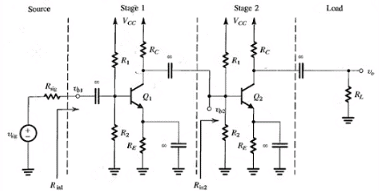Test: Biasing In BJT Amplifier Circuits & Spread Spectrum - Electronics and Communication Engineering (ECE) MCQ
18 Questions MCQ Test - Test: Biasing In BJT Amplifier Circuits & Spread Spectrum
(Q.1-Q.6) consider the figure shown below and answer the questions that proceed.

For Vcc = 15V, R1 = 100 kΩ, R(E) = 3.9 kΩ, R(C) = 6.8 kΩ and ß = 100, determine the dc collector current for each transistor.
For Vcc = 15V, R1 = 100 kΩ, R(E) = 3.9 kΩ, R(C) = 6.8 kΩ and ß = 100, determine the dc collector current for each transistor.
For Vcc = 15V, R1 = 100 kΩ, R(E) = 3.9 kΩ, R(C) = 6.8 kΩ and ß = 100, determine the dc collector voltage for each transistor.
| 1 Crore+ students have signed up on EduRev. Have you? Download the App |
Find R (in 1) for R (sig) = 5 kΩ.
Find Vb1/Vsig for R(sig) = 5 kΩ.
For Rl = 2 kΩ find Vo/Vb2.
Find the overall voltage gain.
(Q.1-Q.3) A pseudo-noise (PN) sequence is generated using a feedback shift register of length m = 4. The chip rate is 107 chips per second.
Q. The PN sequence length is
The period of PN sequence is
A slow FH/MFSK system has the following parameters.
Number of bits per MFSK symbol = 4
Number of MFSK symbol per hop = 5
The processing gain of the system is
A fast FH/MFSK system has the following parameters.
Number of bits per MFSK symbol = 4
Number of pops per MFSK symbol = 4
The processing gain of the system is
(Q.6-Q.7) A rate 1/2 convolution code with dfrec = 10 is used to encode a data sequence occurring at a rate of 1 kbps. The modulation is binary PSK. The DS spread spectrum sequence has a chip rate of 10 MHz.
Q. The coding gain is
(Q.8-Q.9) An FH binary orthogonal FSK system employs an m 15 stage liner feedback shift register that generates an ML sequence. Each state of the shift register selects one of L non over lapping frequency bands in the hopping pattern. The bit rate is 100 bits/s. The demodulator employ non coherent detection.[/expand]
Q. If the hop rate is one per bit, the hopping bandwidth for this channel is
Suppose the hop rate is increased to 2 hops/bit and the receiver uses square law combining the signal over two hops. The hopping bandwidth for this channel is
In a fast FH spread spectrum system, the information is transmitted via FSK with non coherent detection. Suppose there are N = 3 hops/bit with hard decision decoding of the signal in each hop. The channel is AWGN with power spectral density 0.5No and an SNR 20 ~13 dB (total SNR over the three hops). The probability of error for this system is

















